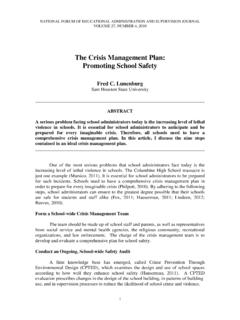Transcription of 5.2 million 1.4 million men - University of Kentucky
1 Many victims do not use the term stalking but they describe stalking behaviors including:INTIMIDATIONI mplicit and explicit threats, third party threats, forced confrontations, property damage, and threatened suicideLIFE INVASIONR epeated unwanted contact in person or by phone, text, email, card/note, message, third party, and social mediaSURVEILLANCEF ollowing, showing up, spying, using technology to keep tabs on the victimINTERFERENCED isruption of the victim s life professionally and socially as well as physical and sexual : Connecting the Dots1 DEFINITION:A course of conduct directed at a specifi c person that creates an implicit or explicit threat and induces fear or concern for personal safety or the safety of close FOR:Impact on Life: Disruptions to the victim s personal, professional, fi nancial, social, and/or academic life and relationshipsConnections: The perpetrator showing up unexpectedly at places the victim goes or incidents that suggest the perpetrator might be following or tracking the victim Indications that the perpetrator is using technology, such as spyware, to monitor, harass, intimidate, sabotage, or stalk the victim Repeated coincidental incidents, such as vandalism to the victim s car or property Other crimes that intersect with stalking (protective order violations, partner abuse, property damage) Threats, especially those that suggest adisregard of consequences (such as arrest, jail, physical harm)Victim resistance: Telling the stalker she/he wants no contact; changing phones, residence, workplace, locks, social groups.
2 Altering life to prevent contactStalker persistence: Repeated attempts by the perpetrator to contact the victim after the victim has directly or indirectly indicated she/he does not want to be contacted and harassedFear: Heightened fear on the part of the victim for self and others, even though she/he might not have been physically assaulted or explicitly millionwomen millionmenwill be stalked each year1TK Logan, (April 2017). For more information email or visit THE VICTIM:About the Course of Conduct1. Is he/she following you, watching you, showing up unexpectedly, or communicating with you in ways that seem obsessive or make you concerned for your safety?2. Has he/she repeatedly initiated unwanted contact with you ( , repeated phone calls, texts, messages, emails, gifts, etc. or through third parties)? 3. Has he/she threatened you or done other things to intimidate you?
3 What has he/she done that has frightened or alarmed you? 4. Has he/she signifi cantly and directly interfered with your life? Has he/she assaulted you while he/she has been stalking, harassing, or threatening you? Has he/she forcibly kept you from leaving or held you against your will, caused you to have a serious accident, physically assaulted your friends or family members or seriously attacked you in other ways?Women are more likely to bevictims of stalkingMen are more likely to bestalkers regardless of victim genderENCOURAGE THE VICTIM TO: KEY QUESTIONWhat would make you feel safer: in your home? In your workplace/school? During child exchanges/visits? Other situations?About Threats5. Have there been any threats to harm you? Threats to harm others you are close to? 6. Have there been threats to destroy property, harm pets, or to sabotage you in other ways?
4 7. Have there been any threats of suicide by the perpetrator if you don t do what he wants?About Fear and Concern for Safety8. Has his/her actions made you afraid for your safety?9. Have you changed your life in any way because you are afraid? If so, how? (ex., installed door locks, cameras, lights; moved; changed jobs; altered schedules; don t go out, etc.)10. What are you most afraid of happening?Avoid minimizing or downplaying safety concerns and threatsPlan for safety by thinking through specifi c threats and vulnerabilities (the goal to make it as diffi cult as possible for the perpetrator to stalk her/him)Preserve evidence and document stalking behaviors in a safe way(check the websites below for documentation logs and tips)Seek support through trusted friends, family, or victim advocatesSee it/acknowledge it as stalking(Check the Stalking and Harassment Assessment Risk Profi le at )CHECK OUTThe Stalking Resource Center at ; the National Domestic Violence Hotline at (1-800-799-7233); the Stalking and Harassment Assessment and Risk Profi le (SHARP) at ; Other Resources ( and ).
5 NOTE: If victims describe behavior that does not superfi cially appear to be threatening/annoying, ask them why the behavior was frightening to them. Why does the victim perceive the behavior as a threat?




